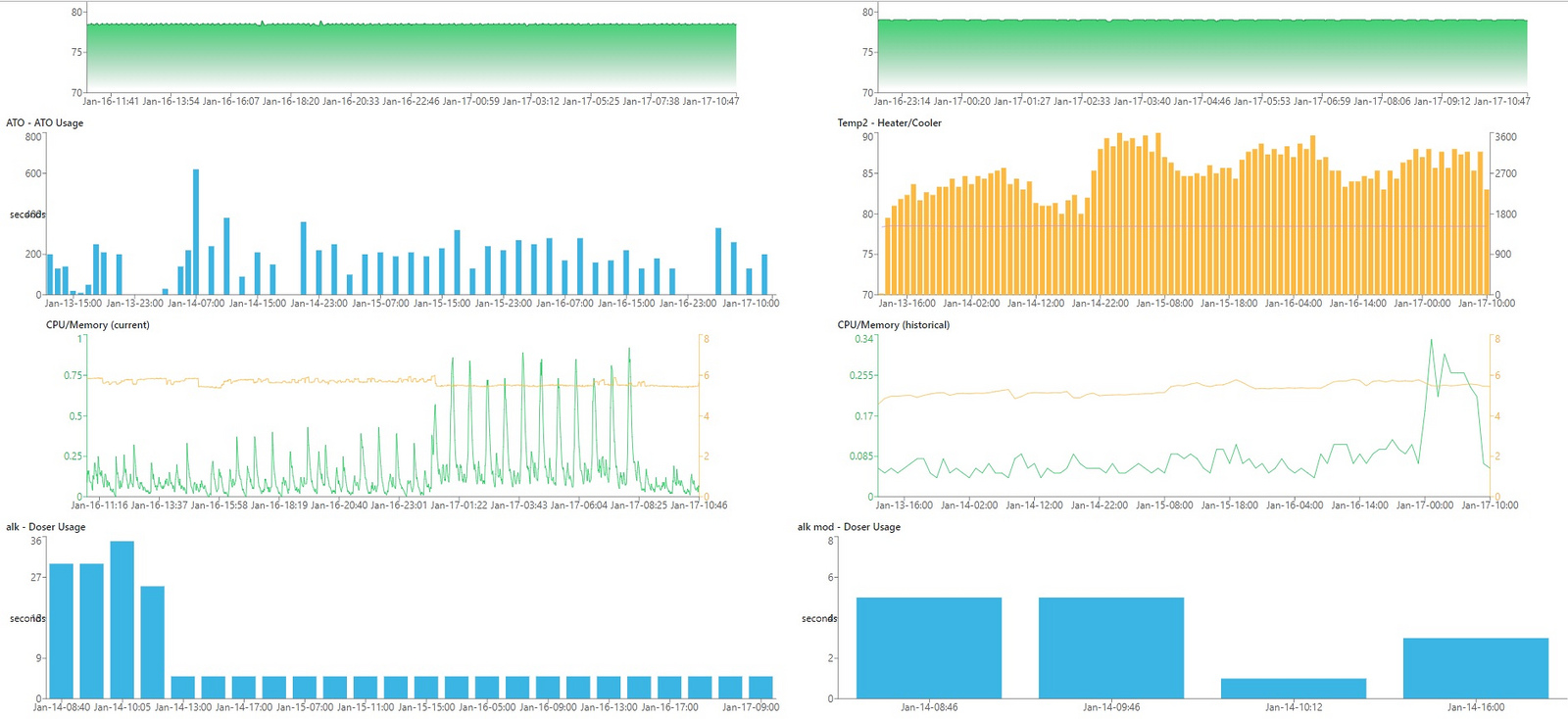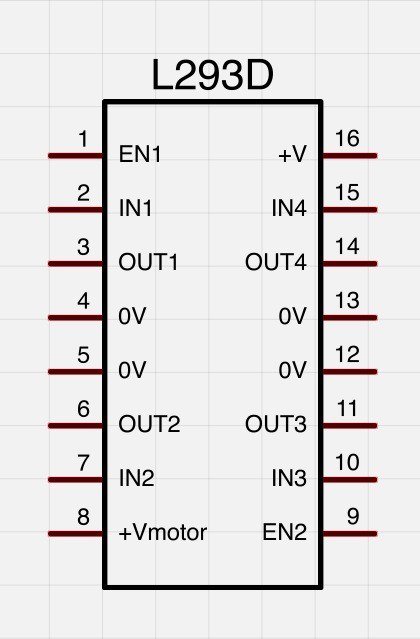it does not set the precision for the probe. This is something we can do. How useful you think this will be? I am able to tune in 0.01 F precision with current setup@Ranjib
Just another question out of curiosity.
Does reef-pi set the precision on the ds18b20 probes (9,10,11 or 12 bit)or does it read the probes as set when bought?
Navigation
Install the app
How to install the app on iOS
Follow along with the video below to see how to install our site as a web app on your home screen.
Note: This feature may not be available in some browsers.
More options
You are using an out of date browser. It may not display this or other websites correctly.
You should upgrade or use an alternative browser.
You should upgrade or use an alternative browser.
reef-pi :: An opensource reef tank controller based on Raspberry Pi.
- Thread starter Ranjib
- Start date
-
- Tags
- controller raspberry-pi
- Tagged users Ranjib
- Joined
- Dec 16, 2018
- Messages
- 1,189
- Reaction score
- 2,826
I was just curious, seems my probes have all come with 12 bit precision set. 12 point precision makes read times go to 750 milliseconds(time it takes the ds18b20 to calculate and send) , so there is a tradeoff there.it does not set the precision for the probe. This is something we can do. How useful you think this will be? I am able to tune in 0.01 F precision with current setup
In case anyone is wondering how precison works at differing levels, this determines the graduations that your temp sensor can read.
9 bit=.5 degree celsius graduations
10 bit=.25 degree celsius graduations
11 bit=.125 degree celsuis graduations
12 bit=.0625 degree celsius graduations
There is a bitbanging script to run on a pi that can write to the ds18b20 and set the precision.
I do wonder though, with all these cheaper probes running around, is everyone working with different precisions set?
Last edited:
can be. worth investigating.I was just curious, seems my probes have all come with 12 bit precision set. 12 point precision makes read times go to 750 milliseconds(time it takes the ds18b20 to calculate and send) , so there is a tradeoff there.
There is a bitbanging script to run on a pi that can write to the ds18b20 and set the precision.
I do wonder though, with all these cheaper probes running around, is everyone working with different precisions set?
can be. worth investigating.
The default resolution at power on is 12 bit.
- Joined
- Dec 16, 2018
- Messages
- 1,189
- Reaction score
- 2,826
Good to know!The default resolution at power on is 12 bit.
So , by default we are running in highest resolution, which we rarely need,. This is good to know, we can have some tips to make thing more performant (for cases where multiple sensors are involved, or we are taking reading more frequently) to reduce the resolution and improve the read performance. Does that make sense?The default resolution at power on is 12 bit.
I am very American in that sense. If there is more resolution, even if useless, meaningless or even mildly wasteful for a number of reasons, I still want it. It's like horsepower, I always want more. I want tighter tolerances on my parts from the machine shop, NIST calibrated thermometers, oversized electrical conductors, electrical parts that are linear over huge temperature ranges that it won't ever even come close to seeing in real use, etc etc.Perfect sense! Maybe an option to let the user set resolution is in order.
- Joined
- Dec 16, 2018
- Messages
- 1,189
- Reaction score
- 2,826
Being an industrial electrician for years, I see nothing wrong with oversize electrical conductors. It eliminates a vast number of problems!I am very American in that sense. If there is more resolution, even if useless, meaningless or even mildly wasteful for a number of reasons, I still want it. It's like horsepower, I always want more. I want tighter tolerances on my parts from the machine shop, NIST calibrated thermometers, oversized electrical conductors, electrical parts that are linear over huge temperature ranges that it won't ever even come close to seeing in real use, etc etc.
And machine shop tolerances, dont get me started, im a service engineer for CNC machinery, I work in micron tolerances.
So far so good. I converted to headless mode on the RPI and it dropped system resources significantly. Here are my resources running a pi3 B+ with Temp, ATO, lights, and dosers. All timers are active, ATO check is 10 seconds, and temp is set to 60 seconds.


PWM control will go to either PRI pins 18 and 19 or come from the PCA9685. If you are just wanting the motor to go in one direction run say the green control signal to ground and the blue to the GPIO output of your choosing. Dont forget to creat the virtual equipment in reefpi for those GPIO controls and turn them on.
Regards to the virtual equipment, I set it up, didn't work how it should with the pca9685, I set up one virtual pump per pump head. Should I set up a second one and set the pin to a ground pin, so as per the tutorial I'll have one off and one on?
For the pump to work, if you have one of the inputs grounded on the motor driver your virtual equipment for the non grounded control pin will need to be on all the time. You have it set to off.
So you would create a virtual equipment for pin 21 (alk) and switch it to on. The other input at the driver should be jumpered to ground.
So you would create a virtual equipment for pin 21 (alk) and switch it to on. The other input at the driver should be jumpered to ground.
So you would create a virtual equipment for pin 21 (alk) and switch it to on. The other input at the driver should be jumpered to ground.
Pretty sure that's what I'd done, I'll check again when I get home, it's possible that the PCA 9685 is faulty, it does light up and is recognised by the pi, however it did come out of an Arduino build which the RTC caught fire and took out a bunch of components with it, I should test it on my Arduino light controller.
- Joined
- Sep 16, 2018
- Messages
- 516
- Reaction score
- 922
I have pretty basic question.
I can access reef-pi from my laptop by typing hostname.local in a web browser. But how do I get the Raspberry pi to display the reef-pi UI through it's own HDMI? I can only seem to get a command line or Raspbian GUI to display through the HDMI.
Thanks,
I can access reef-pi from my laptop by typing hostname.local in a web browser. But how do I get the Raspberry pi to display the reef-pi UI through it's own HDMI? I can only seem to get a command line or Raspbian GUI to display through the HDMI.
Thanks,
- Joined
- May 14, 2018
- Messages
- 44
- Reaction score
- 67
There is always the Apex probe. More expensive ($30) but waterproof. Snip the connector end and you have access to the wires.
I was wondering if anyone has used the APEX temperature probe with a reef-pi? I have already had two of the $10 sensors fail, so a $30 aquarium grade sensor looks like a good deal if it works.
I was wondering if anyone has used the APEX temperature probe with a reef-pi? I have already had two of the $10 sensors fail, so a $30 aquarium grade sensor looks like a good deal if it works.
I believe they are a 10k NTC thermistor. Not directly going to work.
Open the browser in pi and type http://localhostI have pretty basic question.
I can access reef-pi from my laptop by typing hostname.local in a web browser. But how do I get the Raspberry pi to display the reef-pi UI through it's own HDMI? I can only seem to get a command line or Raspbian GUI to display through the HDMI.
Thanks,
Are you using l293d? Do you have a build thread? I want to take a look at the physical circuit. If you are using l293d checkout this schematicRegards to the virtual equipment, I set it up, didn't work how it should with the pca9685, I set up one virtual pump per pump head. Should I set up a second one and set the pin to a ground pin, so as per the tutorial I'll have one off and one on?





You can verify with a multimeter that the circuit is doing what it supposed to do. You should observer the voltage in EN1 or EN2 to vary as you update the doser speed (this is the pin connected to pi or pca9685 pwm output) and among IN1, IN2 one of them should +ve (3.3v) and the other should be GND. and same for IN3/IN4. Finally check vmotor has some voltage, and then out1/out2 should vary as you vary the pwm. check all these pins voltage as you independently switch on/off equipment and change the speed, independently. If you are methodical and independently test the circuit connections, you will surely get to the bottom of this.
Similar threads
- Replies
- 8
- Views
- 164


















